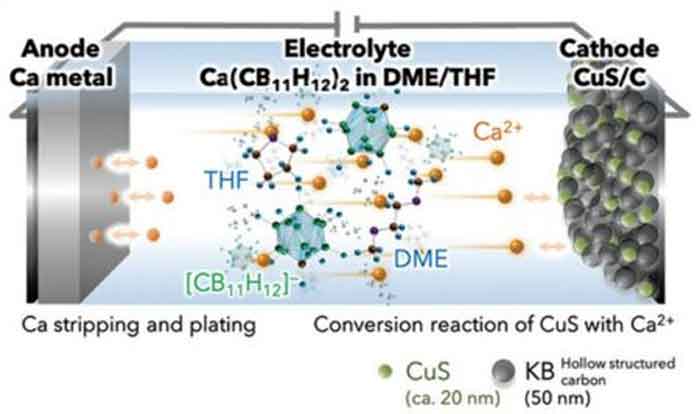Send this article to a friend:
May
30
2023
Send this article to a friend: May |
Scientists Report Breakthrough With Very Low Cost Calcium Battery
With the compulsive sales of electric vehicles and grid-scale energy storage systems on the rise, the need to explore alternatives to lithium-ion batteries has never been greater. The breakthrough has just been reported in the journal Advanced Science. The advancement is focused on the element calcium and now a prototype is in testing. Calcium (Ca) is the fifth most abundant element in earth’s crust, calcium is widely available and inexpensive, and has higher energy density potential than lithium ion batteries (LIB). Its properties are also thought to help accelerate ion transport and diffusion in electrolytes and cathode materials, giving it an edge over other LIB-alternatives such as magnesium and zinc. But many hurdles remain in the way of Ca metal batteries’ commercial viability. The lack of an efficient electrolyte and the absence of cathode materials with sufficient Ca2+ storage capabilities have proved to be the main stumbling blocks.  Schematic of a prototype Ca metal battery. The battery comprises a Ca2+-storing positive electrode containing the CuS/C composite and a Ca plating/stripping negative electrode with a hydride-based electrolyte, Ca(CB11H12)2 in DME/THF. Image Credit: Tohoku University. Click both the press release and the open access study report for more images and information. In 2021, some members of the current research group provided a solution to the former problem when they realized a new fluorine-free calcium electrolyte based on a hydrogen (monocarborane) cluster. The electrolyte demonstrated markedly improved electrochemical performances such as high conductivity and high electrochemical stabilities. Kazuaki Kisu, assistant professor at Tohoku University’s Institute for Materials Research said, “For our current research, we tested the long-term operation of a Ca metal battery with a copper sulfide (CuS) nanoparticle/carbon composite cathode and a hydride-based electrolyte.” Also a natural mineral, CuS has favorable electrochemical properties. Its layered structure enables it to store a variety of cations, including lithium, sodium and magnesium. It has a large theoretical capacity of 560 mAh g-1 – two to three times higher than present cathode materials for lithium-ion batteries. Through nanoparticulation and compositing with carbon materials, Kisu and his colleagues were able to create a cathode capable of storing large amounts of calcium ions. When employed with the hydride-type electrolyte, they produce a battery with a highly stable cycling performance. The prototype battery maintained 92% capacity retention over 500 cycles based on the capacity of the 10th cycle. The group is confident that their breakthrough will help advance research into cathode materials for Ca-based batteries. “Our study confirms the feasibility of Ca metal anodes for long-term operations, and we are hopeful the results will expedite the development of Ca metal batteries,” said Kisu. *** When one thinks about low cost materials, calcium and its naturally occurring forms comes to mind really quickly. The theoretical potential is outstanding. Getting it to work is now a strong possibility. Calcium based batteries might make electric vehicles a practical reality. At the moment the practicality is factually a niche, and a not particularly big one at that. Weight has to be reduced dramatically, cost come down by a factor of 5 or more, charge time immensely cut and safety improved such that they can be parked in a garage without the insurance company going nuts. That makes this important news. Yes it's a new born technology, but over time the potential is simply huge and the demand for electrical storage grows by the second. By Brian Westenhaus via Newenergyandfuel.com
Brian is the editor of the popular energy technology site New Energy and Fuel. The site’s mission is to inform, stimulate, amuse and abuse the news and views across the emerging field of energy and fuels in our future. You will find the most exciting and useful news, guides and tips for making and saving money in energy and fuel, just how things work or not, where you might want to invest or get involved in a brainstorming session with other readers.
|
Send this article to a friend:
 |
 |
 |